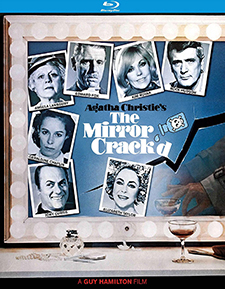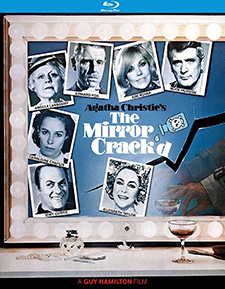Mirror Crack’d, The (Blu-ray Review)

Director
Guy HamiltonRelease Date(s)
1980 (September 1, 2020)Studio(s)
EMI Films/GW Films/Associated Film Distribution (Kino Lorber Studio Classics)- Film/Program Grade: A-
- Video Grade: A
- Audio Grade: A
- Extras Grade: B-
Review
As The Mirror Crack’d opens, we are watching a black-and-white mystery movie called Murder at Midnight. A police inspector has assembled a group of people at a mansion and is about to announce the killer when the film breaks and the actual setting is revealed in color—a social hall in a vicarage in St. Mary Mead. The vicar, doubling as projectionist, assures the small assemblage that he will repair the broken reel and continue the movie, but one woman in the audience sees no reason to wait. As she gathers up her belongings and makes her way out, viewers ask her opinion about the identity of the killer. With methodical precision, she analyzes what has transpired, eliminates suspects, and tells the crowd who the fictional killer is.
Thus are we introduced to Miss Jane Marple (Angela Lansbury), amateur sleuth and one of Agatha Christie’s most famous characters. Set in the early 1950s, the story focuses on an American movie company that has come to a small English village to shoot a period film starring Marina Rudd (Elizabeth Taylor), making a comeback after years off the screen, and directed by Marina’s husband, Jason Rudd (Rock Hudson). During a reception at the country estate they rented, one of the guests (Maureen Bennett) suddenly collapses and dies. Miss Marple’s nephew, Scotland Yard inspector Dermot Craddock (Edward Fox), comes to the village to investigate, and he and his aunt speculate on the strange circumstances of the woman’s inexplicable death.
As whodunits go, The Mirror Crack’d checks all the boxes—a lavish setting, plenty of colorful characters, red herrings, and surprise revelations. Added to this is considerable star power. Along with Elizabeth Taylor and Rock Hudson, the film features Kim Novak as Lola Brewster, a longtime rival of Marina, Geraldine Chaplin as Marina’s personal assistant, and Tony Curtis as the producer of the film and Lola’s husband.
Taking on the role played earlier on screen by Margaret Rutherford, Lansbury is excellent as Miss Marple but is too often off screen, with most of the action concentrated on the filmmakers. Each of Lansbury’s appearances peps up the sometimes ponderous narrative with Miss Marple’s nosiness, love of gossip, and wit balancing the murder investigation.
Taylor is perfect as a glamorous movie star and is photographed beautifully in striking outfits befitting Marina’s celebrity. Marina has a tragic back story, which humanizes her and explains her absence from the screen for so many years. Her new movie, in which she is to star as Mary, Queen of Scots, is her hoped-for comeback, so much is riding on its success.
The Mirror Crack’d looks great, with its picture post card village, period costumes, and opulent interiors. Director Guy Hamilton (Goldfinger) successfully moves the action to avoid an old-fashioned, static, drawing-room mystery look. He takes full advantage of the locations and sets the action in a number of diverse settings, including Miss Marple’s thatched-roof house, the movie set, rooms at the estate that’s hosting Marina and Jason, and an important flashback at a theater.
The film is great fun and works as both a whodunit and a character study of a quirky woman who is challenged by what confuses others and is an old hand at solving mysteries. As with her fictional predecessor Sherlock Holmes, we delight in seeing her strip away the layers and uncover the truth.
Featuring 1080p resolution, The Mirror Crack’d is presented by Kino Lorber Studio Classics on Blu-ray in the widescreen aspect ratio of 1.85:1. This 2K restoration is sharp with details well delineated, such as the flowers in Elizabeth Taylor’s purple and white flowered hat, patterns in clothing, brick work in buildings, facial age lines, grain in wood paneling, Taylor’s vibrant fuchsia lipstick, and a pristine black-and-white film within the film. The cinematography is flattering to both Taylor and Kim Novak. Dressed in vibrant shades of purple and pink, respectively, with elaborate hats to match, they stand out from all the others. Director Hamilton favors brief shots with a stationary camera rather than elaborate sweeping tracking shots. He uses slow zooms for key dialogue. Michael Stringer’s production design nicely suggests a vast British mansion in the monochromatic opening sequence, incorporates period cars, and believably suggests the controlled chaos of a movie set with its bustling crew members, bright lights, microphones, and period costumes.
The soundtrack is English Mono DTS-High Definition Master Audio (subtitles in English SDH are also available). The dialogue is especially important, since details about characters, clues, and personal observations move the story and help piece the mystery together. Dialogue is sharp and precise. A rousing version of There’s No Business Like Show Business is played by the local band when Marina makes her first appearance. John Cameron’s score uses ominous chords in the opening black-and-white sequence and is much lighter when we see shots of St. Mary Mead. Most scenes involve conversations between or among characters. The outdoor reception nicely balances dialogue with ambient crowd noise, band music, and sound effects.
Bonus materials include an audio commentary, 2 TV spots, and 7 theatrical trailers.
Audio Commentary – Film historians Howard S. Berger, Steve Mitchell, and Nathaniel Thompson share this commentary. The black-and-white sequence that starts the film is referred to as a “stuffy opener,” a kind of tip of the hat to both British cinema and mystery cinema. Director Guy Hamilton found the script “awfully funny” and the comedy just as important as the whodunit. Elizabeth Taylor and Kim Novak enjoyed playing the cattiness of their characters. Taylor, married at the time to Sen. John Warner, hadn’t made a film in two years and was eager to work with old friends. Taylor, Novak, Rock Hudson, and Tony Curtis were “fish out of water” since their peak careers were behind them. The film reflects the British fascination with American movies and movie stars. The film lacks the forceful detective of Murder on the Orient Express. Miss Marple and nephew Dermot Craddock help each other in unlocking the mystery. They trust each other’s insights and form their own intimate investigative unit. Miss Marple has tremendous curiosity and an “appetite for murder.” Later in the film, the emphasis shifts from the film people to Inspector Craddock. Angela Lansbury’s Miss Marple is compared to her Jessica Fletcher character in Murder, She Wrote which, despite her long career, she is best known for—a testament to the power of television. Taylor’s nuanced performance is discussed. She was a star who could back up stardom with talent. Starting as a child star at MGM, she grew into a very good actress. The mystery genre was traditionally thought of as “second tier.” With a few exceptions, most mystery films of the 1950s were B pictures.
Trailers – The following trailers are included: The Mirror Crack’d, Death on the Nile, Evil Under the Sun, Witness for the Prosecution, Endless Night, Ordeal by Innocence, and Ten Little Indians.
– Dennis Seuling

